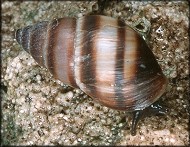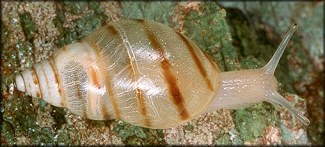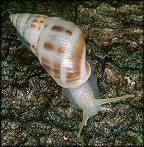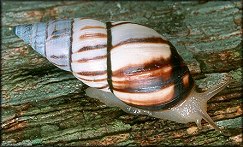| Second Bananas |
| By Phil Poland |
| While South Florida is known for its large and colorful
tree snails, restrictions on the collecting of Liguus and Orthalicus leave
us with buying or trading for existing stock as our only option for obtaining
specimens. Some of us prefer the hunt, whether we collect or not - that’s me. Fortunately there are a lot of snails in Florida that can be legally pursued, including some very pretty arboreal ones closely related to the "forbidden fruit" (Liguus and Orthalicus) of the family Orthalicidae. These are snails of the genera Bulimulus and Drymaeus, which have been assigned to a sibling family, Bulimulidae, by R. Tucker Abbott in his Compendium of Landshells. While other authors have used different taxonomic arrangements, this recent and popular reference is followed here. Four species of this family have been found in Florida: Bulimulus guadalupensis (Bruguière, 1789), Drymaeus dominicus (Reeve, 1850), Drymaeus dormani (W. G. Binney, 1857) and Drymaeus multilineatus (Say, 1825). (Click on the images to see a full sized version)
I was visiting a fellow snailer in Miami Beach one summer, after a rain, when I stumbled across this species for the first time. His walls and shrubs were thick with them and he hadn’t noticed. In Miami, I found it in front of Madonna’s house – no kidding, in Coconut Grove, and near Matheson Hammock. Most recently, I found it in Goodland, on Florida’s southwest coast, on buildings and shrubs.
I’ve found this species on trees throughout the Everglades, the Keys, and on the southeastern coast of Florida.
I first found this species while canoeing on the Silver River near Ocala. The fairly large and almost white shell stood out clearly against the wet trunk of a cypress tree. I’ve also found it on hardwoods and cypress along the Withlacoochee and Hillsborough Rivers. Last month, during a rain, I found them laying their little round white eggs in the leaf mould at the bases of trees near a central Florida river. Assistant Editor Harry Lee’s November 1977 Shell-O-Gram article, entitled On Tree Snails, discussed this species' positive service to citrus growers by controlling saprophytic sooty mold in their groves.
My first memory of Drymaeus was of a colony of D. multilineatus in vines on a trellis in a friend’s yard. It was about 1956 in North Miami Beach, and we were about eight. I traded a pile of comic books for the rights to transplant the lot of them to the shrubs in my own yard. I had Liguus in my yard too. I stayed at the Seashell Motel in Naples last summer and found this species on the walks, walls and shrubs there. It was my first record of this species on the west coast. These four species aren’t always easy to find. Rain makes a huge difference. After a downpour, what had been snailless terrain can become alive with them. The color images accompanying this story were all shot on short notice, based on reports of heavy rain in Miami. |



